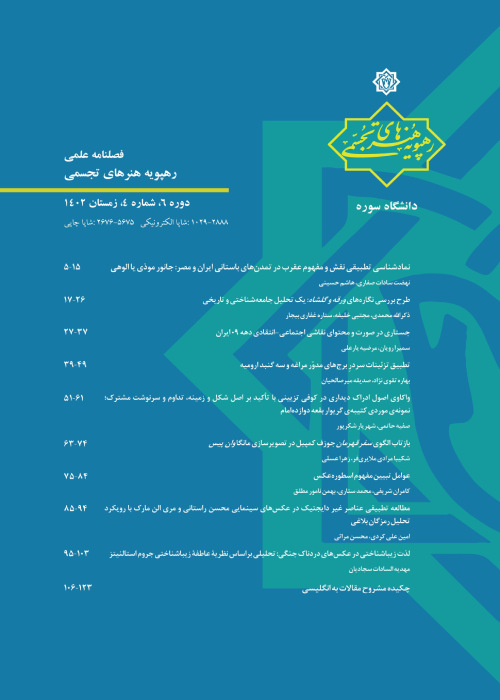The Painting of Nasir al-Din Shah and Two Courtiers, the Discourse of a Hidden Struggle in the Court Structure
In critical discourse analysis theory, there is a tendency to analyze images as if they are linguistic texts. In the Qajar era, the institution of court painting (Naghashkhaneh) was the place of creation and supervision of various genres of the arts of illustrations, which Single-Page watercolor paintings were one of them. Some of these paintings show the royal family and courtiers; therefore, they directly relate to power relations and structures, and contain ideological indications that were often creating to represent the regnant power and to consolidate its ideological content. The watercolor painting from “Nasir al-Din shah Qajar” and two courtiers” which created by the court painter, Mohammad Hassan Afshar, and the support of an anonymous court patron- both as the participants in creation stage- is one of the artworks of Nasir al-Din shah period, which is studied in this article as a discourse based on Norman Fairclough’s theory of “Critical discourse analysis”. Fairclough’s theory is one of the important and reference theories in the field of “discourse” in which he has discussed linguistic phenomena and discourse actions, ideological processes of discourse, relations between language and power, dominance and power relations, and social reproduction in inter-discourse and inter-textual relations. According to him, discourse is an interwoven set of three dimensions of social action, discursive action (production, distribution and consumption of text) and text. As a result, the analysis of a specific discourse requires the analysis of each of these three dimensions and the relationships between them. In this discourse, there are verbal text in the composition of the image that describe the characters, so the image has an interdiscoursive space and both verbal and visual text and their interaction with each other have been analyzed. In this painting, the painter, in a symmetrical composition of asymmetry, places the minister, Mirza Aga Khan Nouri, sitting on the floor on a hypothetical vertical line in the middle of the image as a traditional symbol of power, the king, Nasir al-Din, on the left side and Seif al-mulk who was Iran’s ambassador to Russia and a general on the right side; so according to the rules and concepts of Persian painting which always were showing the king as the source of power in the middle of the image, the painter based on his background knowledge from political situation of court, Has started the process of making denaturalization and has revealed a hidden power struggle between the king and the prime minister The main question of the present study is what is the hegemonic and dominant ideology in this discourse and whether the orders of discourses influencing this discourse has taken steps to consolidate, weaken or change the hegemonic ideology and power? To answer this question, based on Fairclough’s three-dimensional model, this painting has been studied in three stages: textual description, discourse interpretation and social explanation, which, as a matter of necessity, and as Fairclough has argued in his theory, the authors have been constantly moving between these three stages. It seems that this painting in the stage of social explanation shows that the painter- in the position of both an activist and a creative commentator- has attracted the opinion of the possible patron of the artwork, Mirza Aga Khan Nouri, in order to show his great power on one hand, and on the other hand, he identified a secret conflict that by presenting multifaceted signs that no one except Nasir al-Din Shah could win finally, because of his absolute power as the shadow of God in Iran! Therefore, the achievement of this research is that in this struggle, contrary to the first semantic layer, which seems to show the Prime minister as the source of power and the symbol of traditional ideology, in the hidden layers of meaning, the dominant ideology still emphasizes the absolute power of shah. But this absolute authority follows a new structure based on a mixture of discourse orders of modernism and westernization, archaic thought based on the concept of charisma and royal charisma, and the utilization of religion; Also it can be said that Hassan Afshar’s view as the artist who has worked in the institution of the Painting House of the court, was not only a reflection of the orders of discourses in political and social institutions and structures, but also it has done a hidden change in the orders of discourses of painting institution in the court. According to this perspective, in a dialectical relationship, the artist as a discourse activist in this visual text has been effective on the changes on orders of discourses in the field of court politics in a small level.


